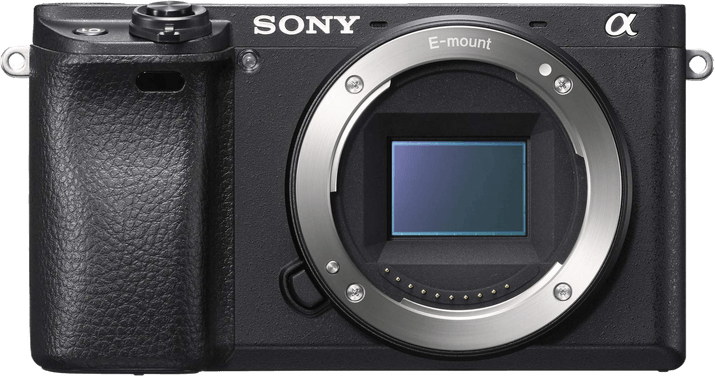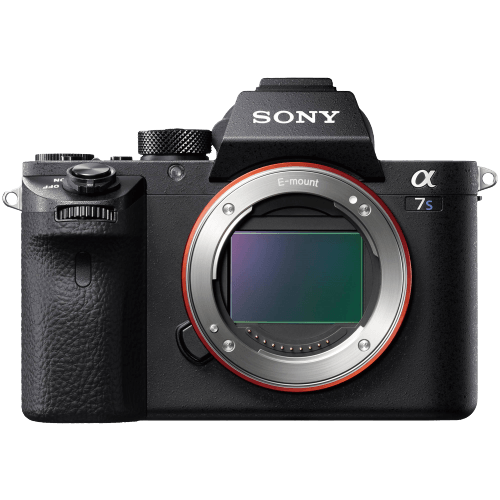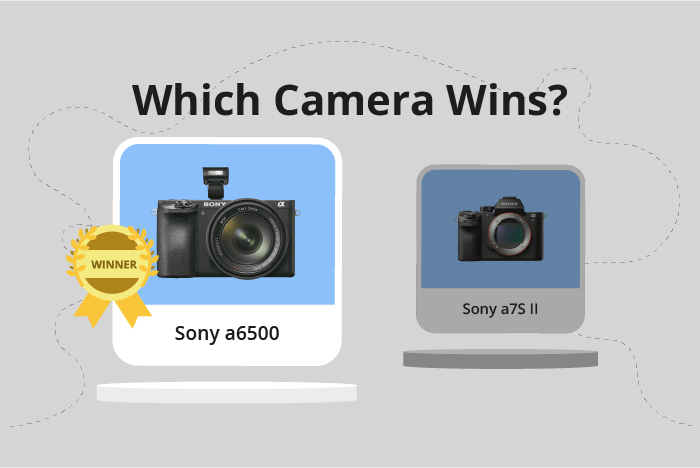Sony a6500 vs a7S II Comparison
Sony a6500

Sony a7S II

The Sony a6500 comes out on top with a score of 72/100, compared to the Sony a7S II‘s 60/100. Both cameras share similarities, such as being mirrorless and having similar announcement dates, with the a6500 in October 2016 and the a7S II in September 2015. The a6500 is lighter at 453g and smaller in size, measuring 120 x 67 x 53mm, making it more portable than the a7S II, which weighs 627g and has dimensions of 127 x 96 x 60mm. Additionally, the a6500 has a lower launch price of $1400, compared to the a7S II’s $3000.
However, the Sony a7S II has its advantages, such as being available for a longer time, giving it a larger user base and more reviews. When considering the specifications and scores, the Sony a6500 is the better option for those looking for a more compact and budget-friendly camera, while the Sony a7S II might be preferred by those who value a longer market presence.
Sony a6500 vs a7S II Overview and Optics
The Sony a6500 outperforms the Sony a7S II in optics, scoring 74/100 compared to the latter’s 66/100. Both cameras have certain specifications in common, which include the CMOS sensor type, the Bionz X processor, a DXOMARK score of 85 for the sensor, Sony lens mounts, and image stabilization. However, the a6500 has several advantages that contribute to its higher score.
The a6500 has a higher megapixel count of 24.2, compared to the a7S II’s 12.2. This results in the a6500 capturing more detail and producing sharper images. Additionally, the a6500 has a faster shooting speed of 11 frames per second, enabling it to capture fast-moving subjects more effectively than the a7S II, which has a shooting speed of only 5 frames per second. The a6500 also benefits from an APS-C sensor size, which is smaller and lighter than the a7S II’s full-frame sensor, making the camera more portable and easier to handle.
On the other hand, the a7S II’s full-frame sensor provides a larger surface area for light gathering, which can result in better low-light performance and dynamic range. This makes the a7S II a strong contender for photographers who prioritize low-light capabilities.
In terms of optics, the Sony a6500 stands out due to its higher megapixel count and faster shooting speed. This makes it an excellent choice for photographers who require sharp, detailed images and the ability to capture fast-moving subjects. The a7S II, however, may be more suitable for low-light photography thanks to its full-frame sensor. Ultimately, the choice between these two cameras depends on the specific needs and preferences of the photographer.
Sony a6500 vs a7S II Video Performance
The Sony a6500 outperforms the Sony a7S II in video capabilities with a score of 77/100, while the a7S II scores 56/100. Both cameras share common features, such as 4K video resolution and maximum video dimensions of 3840 x 2160. However, neither camera has built-in time-lapse functionality.
The a6500’s higher score is due to its superior specs, such as a maximum video frame rate of 120fps, which is significantly faster than the a7S II’s 30fps. This allows the a6500 to capture smoother and more detailed slow-motion footage. The a7S II, on the other hand, does not offer any clear advantages in video capabilities over the a6500.
While the a7S II may not excel in video performance compared to the a6500, it still provides satisfactory results for casual users or those who do not require the high frame rates for their projects. The 30fps on the a7S II is still sufficient for standard video recording and will meet the needs of many users.
The Sony a6500’s higher video score and better specifications make it the clear choice for users prioritizing video capabilities. The a7S II, although not as impressive in this aspect, remains a decent option for those with more modest video requirements.
Sony a6500 vs a7S II Features and Benefits
The Sony a6500 outperforms the Sony a7S II in features, scoring 81/100 compared to the a7S II’s 57/100. Both cameras share some common specifications, including a 3-inch screen size, flip screen, no GPS, and WIFI connectivity. However, the a6500 takes the lead with its additional features.
The Sony a6500 is superior in terms of screen functionality, offering a touchscreen, which the a7S II lacks. This feature allows for quicker and more intuitive control of the camera. Additionally, the a6500 is equipped with Bluetooth connectivity, providing an extra means of connection with other devices and enhancing its versatility.
On the other hand, the Sony a7S II does have a higher screen resolution of 1,228,800 dots, compared to the a6500’s 921,600 dots. This results in a sharper and more detailed image display on the a7S II’s screen. Despite this advantage, it does not make up for the overall difference in feature scores.
Taking these points into consideration, it is evident that the Sony a6500 offers more advanced features than the Sony a7S II. With a touchscreen and Bluetooth connectivity, the a6500 provides a more seamless user experience. Although the a7S II’s screen resolution is higher, this single advantage is not enough to compensate for the a6500’s comprehensive array of features. Consequently, the Sony a6500 is the superior choice in terms of features.
Sony a6500 vs a7S II Storage and Battery
The Sony a6500 and Sony a7S II tie in storage and battery scores, both receiving 21/100. They share similarities in storage and battery specifications, such as having one memory card slot and accepting SD/SDHC/SDXC and Memory Stick Pro Duo cards. Both cameras use the NP-FW50 battery type and do not offer USB charging.
However, the Sony a7S II edges out the a6500 in battery life, capable of capturing 370 shots compared to the a6500’s 350 shots. This advantage, though minor, may be beneficial for photographers who require slightly longer shooting sessions without changing batteries.
On the other hand, the a6500 accepts Memory Stick Pro Duo cards, while the a7S II is compatible with Memory Stick Duo/Pro Duo/Pro-HG Duo cards. This difference may not significantly impact the overall performance of the cameras but can be a deciding factor for users who prefer specific memory card types.
Both cameras have their strengths and weaknesses in storage and battery aspects, with the a7S II offering slightly better battery life and the a6500 providing an additional memory card compatibility option. Ultimately, the choice between these cameras depends on the user’s specific needs and preferences.
Alternatives to the Sony a6500 and a7S II
Are you still undecided about which camera is right for you? Have a look at these popular comparisons that feature the Sony a6500 or the Sony a7S II:

